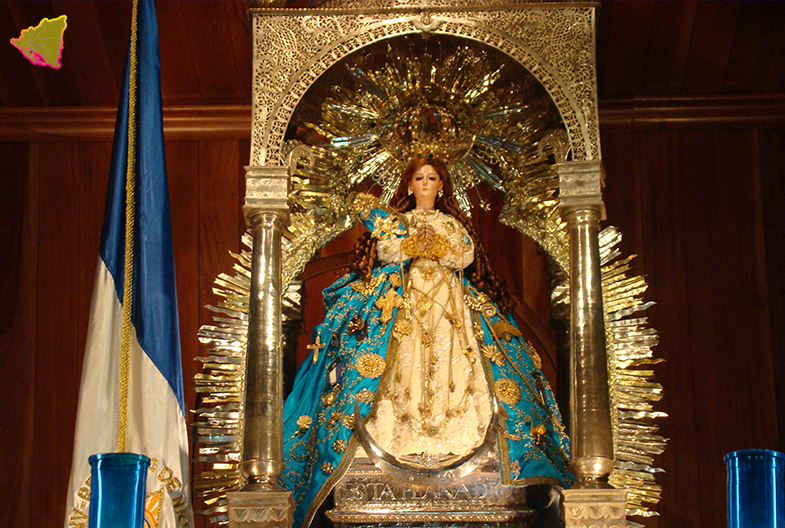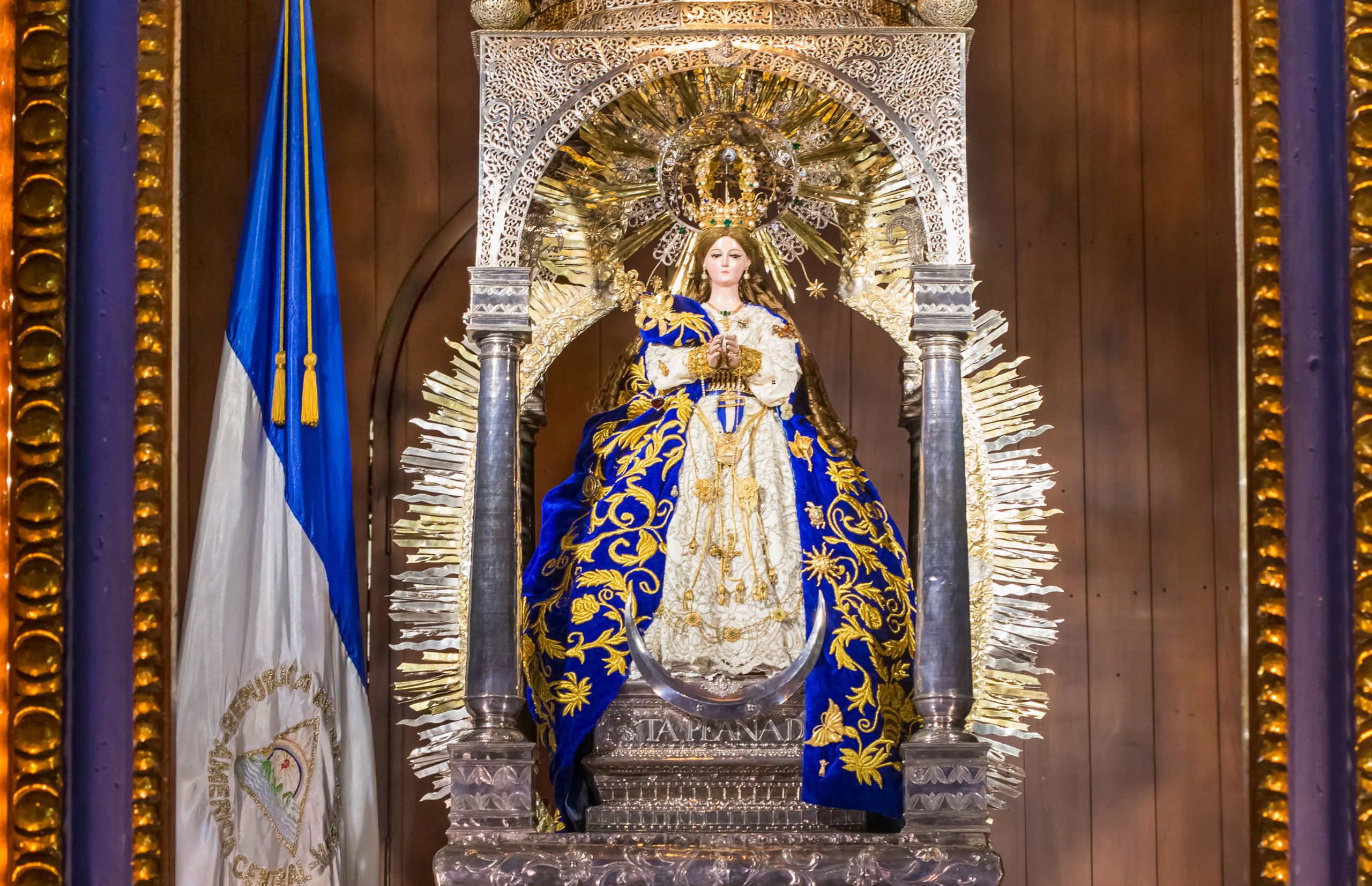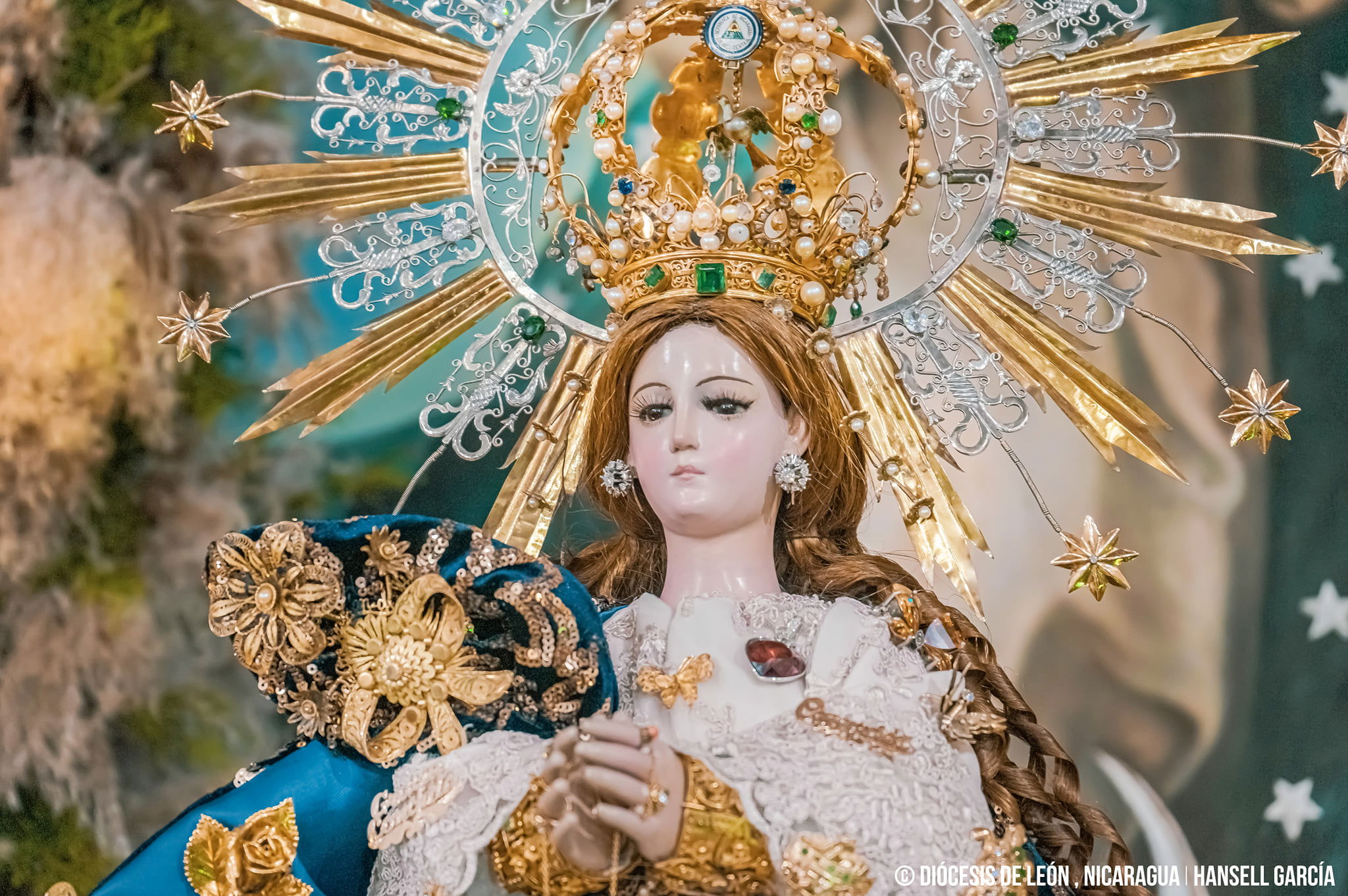OUR LADY OF CONCEPTIONNATIONAL PATRONESS OF NICARAGUA

Feast: December 8th
The Nicaraguan people are characterized by their great devotion to their patron saint, "La Inmaculada Concepción" or, as she is popularly called with great affection, "La Purísima". They celebrate her with great joy on her feast day, December 8, and invoke her with singular esteem throughout the year.
Although other representations of the Immaculate Conception, for example that of Murillo, are perhaps better known in Nicaragua, the official patroness is the one venerated in the National Sanctuary of Our Lady of the Conception of El Viejo. El Viejo being the name of the town near Chinandega and the famous San Cristobal volcano. The Virgin venerated there has a distinguished and providential history that manifests the love of God and the Virgin for the Nicaraguan people.
History
By the sixteenth century the town had eleven neighborhoods with as many chapels and a convent of Franciscan missionaries. It was inhabited by many "ladino" Indians, that is to say, that spoke Spanish and dressed in Castilian clothes. There were also in the town several inns, or tambos, that served as lodging for the poor and recently arrived Spaniards while they awaited their passage to Peru.
They embarked at the port of Realejo, which was the port of commerce with Peru and Guatemala. There are several historical documents, kept in the parish archives of that city, that give certain testimony of the origin and antiquity of the image of Mary Immaculate, one of these documents is the testimony that the Bishop of Nicaragua, Monsignor Simeón Pereira y Castellón, ordered to be taken out of the parish archives on November 20, 1903. It is a declaration made by the Bishop of Nicaragua, Monsignor Juan de Roxas y Ansa, of the Sacred Royal and Military Order of Our Lady of Mercy who at the request of the Provincial and the Procurator General, Reverend Father Francisco de Llarduz gave a letter from his predecessor in the Bishopric, Monsignor Alonso Bravo De Lagunas, who had made a declaration related to the Virgin of the Conception of the Viejo.
An excerpt of the letter says: "And it is true that it is known to us by which to all the people who see the present, we make it known that last year of 1672, for the month of December, being in the convent of N. Señora de la Concepción of the town of El Viejo, filled with our devotion, we wanted to know the origin of said Most Holy image of Nuestra Señora del Viejo, and wanting the Reverend Father Provincial to please our good desires he put in our hands an old book in which was an information made and authorized by the illustrious and most reverend Master Don. Benito Rodriguez de Baltodano on January 5, 1626 and in it it stated that said image had been brought by a brother of the Blessed Saint Teresa of Jesus and he made the grace and donation to the religious of San Francisco of that convent, in which he died, and was buried and there the witnesses affirm under oath, some that they had heard him say, and others, that they had read it in the same instrument (document), in which he says to have declared benefactor to the Religious that that image was of his sister".
Another document that can be consulted to verify the origin of the image and the name and devotion is the one that appeared in the official newspaper of Nicaragua for the year 1875 "La Gaceta", in the number 32 corresponding to June 5, 1875. This document is the Apostolic, Topographic, Historical and Statistical Visit of all the towns of Nicaragua and Costa Rica, made in 1751 by the Illustrious Mr. Pedro Agustín Morel de Santa Cruz, Bishop of the Diocese, which was submitted to the knowledge of King Ferdinand VI, on September 8, 1752.
This document reads as follows: "On June 24, 1751, I went to the town of El Viejo, a league away from Chinandega: has its seat in a cheerful plain, but full of fruit trees and some scrubland, composed of Spanish, Ladinos and Indians ....... The church consists of three naves, main chapel and sacristy very capable, of lime and stones, tile, has its high healthy, with four tiers of bricks that take the front and left side: three bells on their poles, and thatched roof, because the tower fell with a tremor; six decent altars: in the largest is placed the Patroness which is the Conception; the title commonly given to it, is Our Lady of the Old Man, this denomination originated from a venerable old brother of St. Teresa of Jesus, came to this town bringing in his company to the referred image: having died in it he left it to the same Church where it was placed, for having been then, an old man the donor, this rename was tributary to the Image, to the Church and to the town: it is thus recorded by tradition of the elders and also by a certification that I have seen, given by the minister don. Juan de Rojas, Bishop of this Diocese, her height is about a rod, her hands and face are dark brown, with no particular perfection that stands out, but so miraculous that her name has spread throughout these provinces and her inhabitants do not cease to come to visit her for comfort and relief, in fact our Lady of the Old Man is the refuge of all needs and the devotion they profess to her is so particular that there is no one who fails to come even from very remote parts to see her and to present her with alms. It is assured to have been so copious that the temple could be made of avocado, whatever it is, what I can testify is that a beautiful and elevated throne of carved and gilded wood on four columns shelters in its center another small one with its stained glass window, in front and its silver litter in which the Lady is. A circle that surrounds her on the outside and a crescent moon at her feet are of the same metal, the dress is of very rich fabric, all strewn with gold, pearls and various precious stones and a large number of these serve to enhance the crown, which is delicately worked gold, finally, from head to toe it is so full of jewels and primors that it can compete with any other of the most ornate in the world...".
We see how both stories correspond and even one quotes the other, giving the testimony that the Virgin of the Old Man was a gift from Saint Teresa of Jesus to her brother who left for the Indies. Two other stories give a broader sense of the origin of the image and devotion among the Nicaraguan people, especially among the Indians and sailors.
Tradition says: "In the port of Realejo, twelve leagues away from the city of Leon, an image of Our Lady called the Old Man is very celebrated, for what I will now say: A certain Old Hermit had embarked in that port for Peru, taking with him an image of the Blessed Virgin. The day came to set sail, and when the anchors were weighed, and the wind was blowing well, the frigate could not move and was still motionless, as if it had been nailed there. The sailors, surprised at the unexpected stoppage, made many diligences. And seeing that they were all in vain, they attributed the unexpected event to God's special disposition, which for some hidden cause so disposed it. They began to suspect that there might be some excommunicated man there, or one who had committed such crimes that heaven would not want the ship, in which there were many innocent people, to take him. And as they could not find out anything, they went after the poor old man, believing, or suspecting, that he was the Jonah of that ship, and that under that habit and the hermit's garb he was concealing some very grave evil or some very grave evil that he had committed. And like Jonah, the sailors of Joppa began to conjure him to tell them who he was and what sins he had committed, for which God was sending them this misfortune, which was more than a storm in the port itself. And it was not long before they threw him into the sea like Jonah.
The Hermit, who was a good man, and of praiseworthy habits, answered them that although he had been a great sinner, at present he did not recognize in himself any crime for which God would punish him and them. But that the Lord gave him to understand that the cause of the detention was that the sacred image that he carried with him did not want to leave that port, and that therefore they should throw him ashore with his image, and that he hoped that the Great Lady of the Realejo would assist them by giving them happy navigation. The sailors calmed down and having thrown him ashore with his image, at once the ship began to move. But first they jumped ashore with the old captain and others, and made vows to the Virgin, that if she carried them happily, on their return they would pay for an altar to be venerated, and henceforth they would have her in that South Sea as the North Star of all their voyages.
They embarked again, leaving the Old Man with his image, and had a very happy voyage. And as the fame of the prodigy spread, the said navigators, as well as those who later on have traveled that sea, have considered her as their Patroness, and have experienced singular providences and favors".
A testimony of the intercession of the Virgin of the Conception of the Old Man is what happened to a ship with its crew, in the port of Realejo: "The ship was in the port, giving bottom with four anchors; but when the captain woke up a quarter to dawn, he realized that his ship had taken a long stretch, and as if there were no anchor, it was going out with the impetus of the current, which is usually very impetuous there. He called to the people, who were asleep, but seeing that they were already near some rocks where it was certain that the ship was in danger of being torn to pieces, and all the people perished, all was shouting and confusion, as usually happens on such occasions. The captain remembered the Virgin of the Old Man, and urged everyone to invoke her and promise to visit her in her sanctuary and offer each one what they could, if she would deliver them, and to confess and receive communion, which is the most pleasing offering to the Lady.
So they did, and taking a prayer, because they had no more moorings, in the name of the Virgin they threw it into the sea. And being so that not even to stop a boat was enough, the ship stopped at once, until the water began to rise and it was able to enter the port and secure itself. They recognized with this the singular providence of the Lady, jumped ashore and went on foot and barefoot to her Sanctuary to thank her and to fulfill their promises, offering a good alms, which they gathered together.
"The last testimony we have is the one written by some Discalced Carmelite Missionaries who on September 3, 1786 left for Peru in the first expedition to these lands.
The fathers disembarked in the port of Caballos de Honduras, on the Atlantic coast, from where on February 1, 1788 they passed, crossing the entire Republic of Honduras, to the port of Realejo, on the Pacific coast where they arrived in the month of April. They traveled a little inland to the town of El Viejo where they stayed in two ranches. In Nicaragua they were joined by four more religious who came from the province of Mexico. During the stay of these fathers in Viejo, they collected from the lips of the inhabitants of the region the same tradition of the Immaculate Conception, taken from the parish archives.
The chronicler of the trip, Father Miguel de la Madre de Dios narrates it this way: "This town would have up to five hundred houses or huts of Indians and some Spaniards. The doctrine was of Franciscans, and in their church, to which we went to say mass every day and to confess Spaniards and Indians, a miraculous image of Our Lady is venerated on the main altar. Its title is of the Assumption and that of Our Lady of the Old Man, which is not only known and venerated in all those provinces, and even in the most remote of Peru, because the fame of her wonders flies to all.... I asked about the origin of this holy image, and they told me that it was a very old tradition in this town and the surrounding areas, that this holy image was a gracious gift of Our Holy Mother Teresa, who in the Incarnation of Avila made to a gentleman of the Cepedas, uncle or brother of hers, at the time of taking leave of the Saint to go to the Indies with the office of Governor of this Province, charging him to esteem and venerate it as a pledge of heaven, and the most secure protection in his navigations and works. So did the good Knight, who always brought her on his pilgrimages, sea and land, with singular devotion and most cordial veneration, to which the most holy image gratefully reciprocated by showing herself a most benign mother in great dangers of body and soul, until she arrived at this town where she resided ordinarily exercising her office, and that the Sovereign Queen continued her mercy with many Spaniards, and particularly with the Indians of this land who came in all their tribulations to the Oratory of the Governor's house, where he always had placed in great decency.
Finished already the time of his government and promoted to another one of Peru, he tried to embark in the port of the Realejo with the Mariano treasure that accompanied the towns of this region; and this one in special until the port, urging to the gentleman with devout supplications and tenderest tears, not to deprive of so celestial Patroness to that land; that they would make from immediately vow to make her a decent temple where she was adored of all. But the Governor did not condescend to their entreaties, so as not to deprive himself of such sovereign patronage, he embarked the holy image and with it he set sail in the ship that awaited him; and having sailed with the wind astern until noon, he had to arrive in the afternoon with the contrary by the bow to the same port. Three other times in the following days the same setback happened; and not finding the experienced pilots natural causes of such adverse effects, they agreed with the passengers that what was holding them back was the Holy Image, which was brought back to land by the cries and tears of those devout people, who persevering fervently in the Realejo, had negotiated the possession of the divine pledge of heaven, to which they could not without recklessness and risk of all withdraw; with which the pious Catholic Knight had to postpone his particular consolation to the common of so many people who carried in procession with many dances and solemn rejoicings the most holy image to the town, where it is today, that being the Knight who gave it already old, it was called Nuestra Señora del Viejo. " (Taken from the book "Vírgenes Conquistadoras que Santa Teresa envió a las Américas" by Fray Severino de Santa Teresa O.C.D.)
We have tried to keep the language used at the time so that the reader can appreciate how, from the first testimonies, all coincide and support each other. We could affirm that Our Lady of the Old Man is the image that St. Teresa of Jesus gave to her brother when he was leaving for the Indies, and see in this a providential sign of God who used this image to shower abundant graces on the people through the intercession of the Blessed Virgin Mary.
Our hearts, upon reading the accounts of those first witnesses, should be filled with a deep love for the Blessed Virgin, who as Mother always watches over all her children, Spanish or Indians, rich or poor; we are all children of the Blessed Virgin Mary; with the Nicaraguan people let us sing to our Mother of Heaven saying: "Sweet hymns singing to Mary, conqueror of the fierce dragon, let us greet the placid day of her beautiful and happy Conception".


